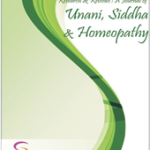[{“box”:0,”content”:”[if 992 equals=”Open Access”]
Open Access
n
[/if 992]n
n
n
n
n
- n t

n
Sangeeta Jain, Devendra Kumar Nama
[/foreach]
n
n
n[if 2099 not_equal=”Yes”]n
- [foreach 286] [if 1175 not_equal=””]n t
- Associate Professor, Assistant Professor, Department of Anatomy, University College of Homoeopathy, Kekri, Department of Anatomy, University College of Homoeopathy, Kekri, Rajasthan, Rajasthan, India, India
n[/if 1175][/foreach]
[/if 2099][if 2099 equals=”Yes”][/if 2099]nn
Abstract
nBackground and justification for the study: Every symptom is an indication of bodily derangements which a patient feels when sick. The medical personal has to recognize these derangements only by symptomatic study of the disease without making any hypothetical theories. Therefore, examining symptoms is the sole correct method for determining the presentation of a disease.
In Homoeopathy, a complete symptom is that which covers location, sensation, modalities and concomitant symptoms. The Location means the anatomical site from where the disease is generating and manifesting its clinical presentation in form of the symptoms. It specifies the precise location, ranging from cellular to organ levels, where the lesion or symptom is manifested.. The meaning of location in the definition of complete symptom is, the seat of the disease; it means the part of the body which is involved in the generation of the disease.
In Homoeopathy, some medicines have affinities to particular location of the symptoms and their particular medicines are documented in Homoeopathic Materia Medicas by various Homoeopaths.
Every organ of the abdominal cavity has its specific location region wise; and disorders related to them are reflected in signs and symptoms expressed by the patient himself or observed by the physician.
Here we are trying to state about the location of the symptom in relation to nine anatomical abdominal regions, ie., epigastric region, right & left hypochondriac regions, umbilical region, right & left lumbar regions, hypogastric region and right & left iliac regions and Homoeopathic medicines related to pathological symptoms of that particular region described by various Homoeopaths
n
Keywords: Nine abdominal regions, Abdominal disorders, Homoeopathic medicines
n[if 424 equals=”Regular Issue”][This article belongs to Research & Reviews : A Journal of Unani, Siddha and Homeopathy(rrjoush)]
n
n
n
n
n
nn
nn[if 992 equals=”Open Access”] Full Text PDF Download[else] nvar fieldValue = “[user_role]”;nif (fieldValue == ‘indexingbodies’) {n document.write(‘Full Text PDF‘);n }nelse if (fieldValue == ‘administrator’) { document.write(‘Full Text PDF‘); }nelse if (fieldValue == ‘rrjoush’) { document.write(‘Full Text PDF‘); }n else { document.write(‘ ‘); }n [/if 992] [if 379 not_equal=””]n
Browse Figures
n
n
n[/if 379]n
References
n[if 1104 equals=””]n
- Sarkar Organon of Medicine by Samuel Hahnemann. 9th reprint ed. New Delhi: Birla publications Pvt. Ltd; 2005.
- Boger (2023). Boger Boenninghausen’s Characteristics & Repertory. New Delhi: B. Jain Publishers Pvt Ltd.
- Robert HA. The principles and art of cure by Homoeopathy. 3rd reprint ed. NewDelhi: B Jain publishers Pvt. Ltd; 2007.
- Close S. The Genius of Homoeopathy lectures and essays on homoeopathic philosophy. 2nd New Delhi: B. Jain Publishers Pvt. Ltd; 2015.
- Garg K, Mittal PS, Chandrupatla M. (2022). BD Chaurasia’s Human Anatomy (Vol 2). 9th New Delhi: CBS Publishers & Distributors Pvt Ltd.
- Drake RL, Vogl AW, Mitchell (2020). Gray’s Anatomy for students (Vol 1). Edinburgh: Churchill Livingstone Elsevier.
- Agur AMR, Dalley (2021). Grant’s Atlas of Anatomy. 15th ed. Philadelphia: Wolters Kluwer Health.
- The nine regions of abdomen [Internet]. 2022 [cited 2024 Feb 24]. Available from: https://organicsmum.weebly.com/newmum/the-nine-regions-of-the-abdominal
- Abdominal regions [Internet]. 2024 [cited 2024 Feb 24]. Available from: https://teachmeanatomy.info/3d-model/region/abdomen/
- Snell (2018). Snell’s clinical anatomy by regions. South Asian ed. Philadelphia: Wolters Kluwer Health
- Kent (2016). Repertory of the Homoeopathic Materia Medica. New Delhi: B. Jain Publishers Pvt Ltd.
- Boericke (2010). Boericke’s New Manual of Homoeopathic Materia Medica with Repertory. New Delhi: B. Jain Publishers Pvt Ltd.
nn[/if 1104][if 1104 not_equal=””]n
- [foreach 1102]n t
- [if 1106 equals=””], [/if 1106][if 1106 not_equal=””],[/if 1106]
n[/foreach]
n[/if 1104]
nn
nn[if 1114 equals=”Yes”]n
n[/if 1114]
n
n

n
Research & Reviews : A Journal of Unani, Siddha and Homeopathy
n
n
n
n
n
n
| Volume | |
| [if 424 equals=”Regular Issue”]Issue[/if 424][if 424 equals=”Special Issue”]Special Issue[/if 424] [if 424 equals=”Conference”][/if 424] | |
| Received | February 19, 2024 |
| Accepted | March 15, 2024 |
| Published |
n
n
n
n
n
nn function myFunction2() {n var x = document.getElementById(“browsefigure”);n if (x.style.display === “block”) {n x.style.display = “none”;n }n else { x.style.display = “Block”; }n }n document.querySelector(“.prevBtn”).addEventListener(“click”, () => {n changeSlides(-1);n });n document.querySelector(“.nextBtn”).addEventListener(“click”, () => {n changeSlides(1);n });n var slideIndex = 1;n showSlides(slideIndex);n function changeSlides(n) {n showSlides((slideIndex += n));n }n function currentSlide(n) {n showSlides((slideIndex = n));n }n function showSlides(n) {n var i;n var slides = document.getElementsByClassName(“Slide”);n var dots = document.getElementsByClassName(“Navdot”);n if (n > slides.length) { slideIndex = 1; }n if (n (item.style.display = “none”));n Array.from(dots).forEach(n item => (item.className = item.className.replace(” selected”, “”))n );n slides[slideIndex – 1].style.display = “block”;n dots[slideIndex – 1].className += ” selected”;n }n”}]

